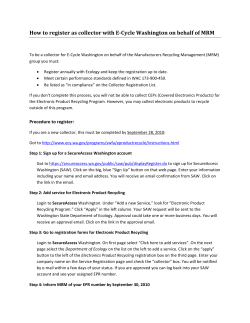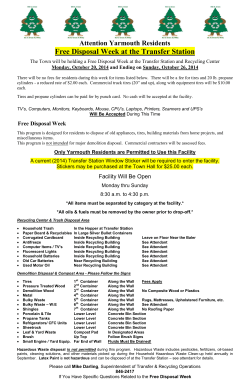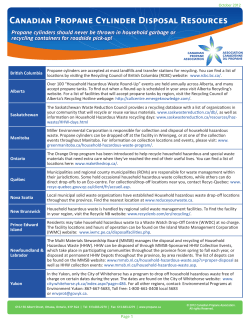
FOREST AND PAPER INDUSTRY
FOREST AND PAPER INDUSTRY A mature industry that has done much to clean up its act. http://individual.utoronto.ca/abdel_rahman/paper/fpmp.html What are the primary environmental issues concerning the forest and paper industry? 1. Sustainability of forest resources: trees + habitats + species + water 2. Clean paper making: transportation to and from paper mill energy consumption water usage bleaching and other chemicals 3. Paper consumption: Can it be reduced? 4. Recycling of used paper and cardboard energy, chemicals recycling vs. incineration 5. Alternatives to wood for paper? Alternatives to paper itself? 1 www.automation.com/sitepages/pid1988.php Paper is a commodity: low design, near impossibility of changing the product itself huge amounts → huge impact nonetheless Paper accounts for 2.5% of industrial production 2.0% of world trade Paper consumption is related to population and to wealth 2 Source: Earth Trends, 2005 data So, we consume more paper than others. Why? Hint: Paper consumption is highly correlated with wealth. 3 For a wide range of countries Zoom on the less wealthy countries (bottom left of previous plot) 4 Look at historical data: GNP is about the only factor affecting paper consumption. Paper Task Force, © 1995 Environmental defense Fund 5 Think of making useful by-products along the way. http://www.agenda2020.org/Tech/Biorefinery/IFPB_research.htm 6 1. Forest logging A tree = 25% branches and bark 75% trunk wood → logs Wood log = 27% lignin (glue) 73% fiber (what goes into paper) Every tree requires 130 gallons (490 L) of water for growth 50 gallons (189 L) of water for processing into paper The production of 1 metric ton of paper requires 17 trees (in average) 24 trees for white office paper, 12 trees for newsprint 25 m3 of water 10,061 kWh of electricity 680 gallons (2.57 m3) of oil 7 1 ton of uncoated virgin (non-recycled) printing and office paper uses 24 trees 1 ton of 100% virgin (non-recycled) newsprint uses 12 trees A "pallet" of copier paper (20-lb. sheet weight) contains 40 cartons and weighs 1 ton. Therefore, 1 carton (10 reams) of 100% virgin copier paper uses 0.6 trees. 1 tree makes 16.67 reams of copy paper or 8,333 sheets. 1 ream (500 sheets) uses 6% of a tree. 1 ton of coated, higher-end virgin magazine paper (as used for high-end magazines) uses a little more than 15 trees (15.36) 1 ton of coated, lower-end virgin magazine paper (used for newsmagazines and most catalogs) uses nearly 8 trees (7.68) (Source: http://www.conservatree.com/learn/EnviroIssues/TreeStats.shtml) Nobody wants to see this: Basic rule: Trees cut + trees lost to forest fires and diseases < trees reaching maturity (on annual basis) But … - Mind soil erosion - Mind habitats - Mind aesthetics In other words, cut in an environmentally conscious way. - Balance the various forest resources: - Lumber and firewood - Paper - Recreation 8 http://www.rurdev.usda.gov/rbs/pub/jan00/trees.htm www.fitzmorrishorselogging.com/ The most environmentally conscious form of logging is with draft horses, especially when a snow cover is present. 9 2. Papermaking chips logs steam chips gr ee n r quo te li whi or liqu ck bla liq uo r paper pulp bleached pulp 10 From logs to chips Some brute force is applied… = energy consumption From chips to pulp Here, the process is chemical The purpose of this step is to remove the lignin (= glue) that holds the wood fibers together. The product is loose fiber in water, called pulp. 11 Pulping From used chemicals to new chemicals Various bleaching technologies using chlorine (Cl2) ECF = Elemental Chlorine Free (use of ClO2 instead of Cl2) TCF = Total Chlorine Free 12 ECF = Elemental Chlorine Free (substitution of Cl2 by chloride dioxide ClO2) TCF = Total Chlorine Free (no Cl in whatever form, use of O3 and H2O2 instead) The ECF vs TCF debate: TECHNOLOGY Arguments pro-ECF or against TCF Arguments pro-TCF or against ECF - ClO2 gives better bleaching - ECF fibers are stronger - Water loop can be closed - TCF technology exists - Easier to start/stop facility - Cl builds in closed loops corrosion leaks - Efficiency of H2O2 is not great ENVIRONMENT - ECF is good enough* - Anti-Cl position is like a religion - Stronger fibers fewer trees & more recycling - ECF generates no dioxin in practice - TCF = only guarantee against release of Cl compounds - Easier to filtrate effluents - Theoretical possibility of producing dioxin from ECF MARKET - Weaker paper from TCF - Low demand for TCF in USA - European demand may not last - Strong European demand for TCF paper ECONOMICS - Too costly to retrofit an existing plant from ECF to TCF - Not more expensive to go TCF when building a new facility - Higher production costs with TCF incl. cutting more trees * with primary and secondary treatment of wastewater 13 3. Recycling First off: Is it better to recycle than to incinerate or landfill? - Recycling → re-use of fibers but energy spent in transportation and remanufacture - Incineration → Getting energy without much transportation Energy produced displaces fossil-fuel energy but cascading not as good as recycling, in principle Also: air emissions! - Landfilling → Least effort but methane emissions during decomposition In general, landfill is least preferable, and there are conflicting opinions regarding incineration versus recycling. In most cases, recycling results in lower total energy cost but with a greater fraction coming from fossil fuel. 14 L = Lower emissions during recycling than during incineration S = Same emissions during recycling as during incineration H = Higher emissions during recycling than during incineration Recycled versus virgin paper: Producing recycled paper involves between 28–70% less energy consumption than virgin paper and uses less water. This is because most of the energy used in papermaking is the pulping needed to turn wood into paper. Recycled paper produces fewer polluting emissions to air (95% of air pollution) and water. Recycled paper is not usually re-bleached and where it is, oxygen rather than chlorine is usually used. This reduces the amount of chlorinated compounds which are released into the environment as a by-product of the chlorine bleaching processes. www.cartoonstock.com/.../r/recycling_paper.asp 15 An additional reason to recycle paper: There is a lot of it in your garbage, and it adds to landfill volume. 16 Source: http://stats.paperrecycles.org/ Basic issues faced in paper/cardboard recycling: - Collection & Sorting - Transportation to sorting/recycling center - Recycling process itself: de-inking, loss in fiber strength, hazardous chemicals - Marketing of recycled paper 17 Challenges in collection and sorting: - Impossibility to capture all forms of paper used by consumers Hygienic paper, waxed paper are not recyclable Harder to collect from individuals than from companies - What is captured ought to be sorted in grade categories P&W = printing and writing (white office paper) OCC = old corrugated cardboard ONP = old newspapers Mixed paper - White office paper has the highest grade for recycling but is relatively hard to collect. More diffuse. Office hang on to documents. Often mixed with magazines, which has the lowest grade (glossy, colors). - Old newspapers are also relatively easy to capture because people pile them up at home. - Collection of corrugated cardboard boxes is relatively easy in back of retail stores such as Walmart. When de-inking does not need to be done 18 If de-inking is involved: (http://www.biomatnet.org/secure/Fair/S502.htm) Those handy Post-It ® 19 Progress is being made with recovery of paper for recycling. For reference: - The American Forest & Paper Association had set a recycling target of 55% for 2012. We take satisfaction in noting that this target was reached and exceeded in 2007! - The recycling rate in Europe was 56.3% in 2006. The theoretical maximum recycling rate for paper is 81% rather than 100% on account of paper that cannot be recycled, such as archives and libraries, and papers used in construction materials. (eubusiness.com) Same data displayed graphically 20 Corrugated cardboard boxes: Generated waste: 29.7 million tons or 12.6% per weight in municipal solid waste (MSW) equivalent to 204.2 lbs. per person 33 million tons total in 2004 Recycled: 21.2 million tons (71.3%) in 2005 (up from about 50% in 1990) Recycled content in new boxes: Generally less than 40% Incinerated or landfilled: 8.5 million tons (5.2%). (Waste Age, January 2006, page 54) Industrial Ecology applied to the forest and paper industry 21 Paper alternatives: The only requirement: Paper must be made from a fibrous material. Fibers can be found in biomass other than wood. For example: KENAF - Kenaf is a plant originating from Africa and is a member of the hibiscus family, currently being tested as an alternative to cutting trees. It can grow up to 12-14 feet in as little as 4 to 5 months. U.S. Department of Agriculture studies show that kenaf yields of 6 to 10 tons of dry fiber per acre per year are generally 3 to 5 times greater than the yield for Southern pine trees. Because kenaf is grown for the fibrous stalk, and not the fruit or flower of the plant, insecticides are not required. (http://showcase.netins.net/web/creativecomposites/FAQs.html) Paper alternatives – continued HEMP - Industrial hemp is illegal in the United States, although it contains far less THC that marijuana. Hemp can produce 10 tons per acre in 4 months and can be grown in a variety of climates. The plant resists diseases and shades out weeds so the use of chemicals is not required during cultivation. Additionally, hemp paper can be recycled 7 times versus 3 times for wood pulp paper. It can also serve as an alternative for edible oil, automotive oil, cooking and heating fuel, fabric, medicine and construction beams. (http://www.toneag.com/hemp.html) COTTON - Cotton is the world's most widely used natural textile fiber, grown in over 70 countries and meeting nearly half of our clothing needs. About 35% percent of the cotton plant is used for fiber. The rest—seeds and gin trash—go into the food chain, either as industrially processed cooking oil or animal feed. Unfortunately conventional cotton farming is extremely chemical-intensive. According to the California-based Sustainable Cotton Project, in the United States, nearly a third of a pound of chemical fertilizers and pesticides is required to produce the pound of fiber that goes into a T-shirt. (http://www.cottonman.com/cotton_bolls.htm) 22 Paper alternatives – continued OTHER - Many of the fibers left from plants we already grow for food go to waste after harvest, including rice, wheat, sugar cane and coffee. In the United States alone, an estimated 150 million tons of straw goes underutilized each year. Much of this waste is burned, only aggravating air pollution. Instead, these remainders can easily and economically be turned into paper. Scrap material such as the leftovers from the manufacturing of denim jeans, or old money can also create tough and beautiful paper products. Source: http://www.lucidskies.com/paper.html Rice paper manufacturing From perspective of priorities: #1 Avoidance is Top Priority. Hence, efforts should be made to go paperless wherever and whenever we can: - Perform banking and other service transactions by internet - Communicate by email instead of regular mail - Marketing on screen instead of brochures, magazines and packages - Get used to reading on screen - Get news from sources other than conventional newspapers - Archive on CDs, not books and reports Electronic libraries - etc. 23 Substitution as avoidance: The issue of “paper vs. plastic” Paper bag vs. plastic bag at grocery store Paper cup vs. polystyrene cup In each case, the life-cycle analysis shows that the non-paper choice is the better choice. Paper bag vs. plastic bag → http://techalive.mtu.edu/meec/module14/title.htm Paper cup vs. styrofoamTM cup → Study by Martin B. Hocking (1991) “Relative merits of polystyrene foam cup and paper in hot drink cups: Implications for packaging” Environmental Management 15 (6): 731–747. (Martin B. Hocking, 1991) 24 Energy per use of each reusable cup (black lines) declines as it is used more times. The energy per use of each disposable cup (green lines) is a constant equal to the manufacturing energy, since it is used only once and is never washed. The numbers in the labels are the manufacturing energies for the different cups. (Source: http://www.ilea.org/lcas/hocking1994.html) 25
© Copyright 2025





















